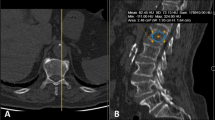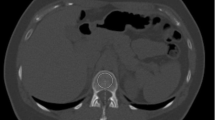Abstract
Summary
Feasibility evaluation of early detection of osteoporosis in oncologic patients by bone mineral density (BMD) on abdominal computed tomography (CT) scans performed for other clinical indications, by using dual-energy X-ray absorptiometry (DXA) as reference. Abdominal CT images can identify patients with osteoporosis BMD without additional radiation exposure or cost.
Introduction
The purpose of the study is to evaluate the feasibility of early detection of osteoporosis by bone mineral density (BMD) on abdominal computed tomography (CT) scans performed in oncologic patients, comparing calibrated and uncalibrated measurements by using dual-energy X-ray absorptiometry (DXA) as reference. We also performed an external validation of a threshold of 160 Hounsfield units (HU), proposed as highly sensitive.
Methods
Cohort comprised CT-DXA pairs within a 6-month period performed for any indication on 326 consecutive adults, aged 62.4 ± 12.38 years (mean ± standard deviation). CT attenuation of trabecular bone in HU was measured at the axial cross sections of L1, L2, L3, and L4 vertebrae. Vertebral compression fractures were assessed by sagittal reconstruction view. Diagnostic performance measures and the area under the receiver operator characteristic curve (AUC) for diagnosing osteoporosis were calculated.
Results
BMD values were statistical significantly lower at any vertebral level from L1 to L4 for patients with osteoporosis defined by DXA (p < 0.001). Calibrated and uncalibrated BMD values were significantly correlated (R 2 = 0.833, p < 0.01). An uncalibrated L1 CT attenuation threshold of 160 HU was more than 90 % sensitive, and a threshold of 73 HU was more than 90 % specific for distinguishing osteoporosis BMD. Fifty-nine percent of patients with vertebral compression fracture had non-osteoporotic DXA T-scores.
Conclusions
Abdominal CT images obtained for other reasons can identify patients with osteoporosis BMD without additional radiation exposure or cost. Uncalibrated values at L1 can detect more osteoporosis patients with spinal compression fractures than DXA in oncologic patients.




Similar content being viewed by others
References
National Institute of Health (1993) Consensus development conference: diagnosis, prophylaxis and treatment of osteoporosis. Am J Med 94(6):646–650
Johnell O, Kanis JA (2006) An estimate of the worldwide prevalence and disability associated with osteoporotic fractures. Osteoporos Int 17(12):1726–1733
WHO Scientific Group on the Prevention and Management of Osteoporosis (2000) Prevention and management of osteoporosis: report of a WHO scientific group (WHO technical report series; 921).
Leslie WD, Giangregorio LM, Yogendran M et al (2012) A population-based analysis of the post-fracture care gap 1996-2008: the situation is not improving. Osteoporos Int 23(5):1623–1629
Watts NB (2004) Fundamentals and pitfalls of bone densitometry using dual-energy X-ray absorptiometry (DXA). Osteoporos Int 15(11):847–854
Lewiecki EM et al (2016) Best practices for dual-energy X-ray absorptiometry measurement and reporting: International Society for Clinical Densitometry Guidance. Journal of Clinical Densitometry: Assessment & Management of Musculoskeletal Health 19(2):127–140
Elliott-Gibson V, Bogoch ER, Jamal SA, Beaton DE (2004) Practice patterns in the diagnosis and treatment of osteoporosis after a fragility fracture: a systematic review. Osteoporos Int 15(10):767–787
Giangregorio L, Papaioannou A, Cranney A, Zytaruk N, Adachi JD (2006) Fragility fractures and the osteoporosis care gap: an international phenomenon. Semin Arthritis Rheum 35(5):293–305
Pickhardt PJ, Pooler BD, Lauder T, Muñoz del Rio A, Bruce RJ, Binkley N (2013) Opportunistic screening for osteoporosis using abdominal computed tomography scans obtained for other indications. Ann Intern Med 158(8):588–595
Summers RM, Baecher N, Yao J et al (2011) Feasibility of simultaneous CT colonography and fully automated bone mineral densitometry in a single examination. J Comput Assist Tomogr 35(2):212–216
Mueller DK, Kutscherenko A, Bartel H, Vlassenbroek A, Ourednicek P, Erckenbrecht J (2011) Phantom-less QCT BMD system as screening tool for osteoporosis without additional radiation. Eur J Radiol 79(3):375–381
Miyabara Y, Holmes D 3rd, Camp J, Miller VM, Kearns AE (2012) Comparison of calibrated and uncalibrated bone mineral density by CT to DEXA in menopausal women. Climacteric 15(4):374–381
Lee S, Chung CK, Oh SH, Park SB (2013) Correlation between bone mineral density measured by dual-energy X-ray absorptiometry and Hounsfield units measured by diagnostic CT in lumbar spine. J Korean Neurosurg Soc 54(5):384–389
Buckens CF, Dijkhuis G, de Keizer B, Verhaar HJ, de Jong PM (2015) Opportunistic screening for osteoporosis on routine computed tomography? An external validation study. Eur Radiol 25(7):2074–2079
Kanis JA, Odén A, McCloskey EV, Johansson H, Wahl DA, Cooper C, IOF Working Group on Epidemiology and Quality of Life (2012) A systematic review of hip fracture incidence and probability of fracture worldwide. Osteoporos Int 23(9):2239–2256
Sanders KM, Pasco JA, Ugoni AM et al (1998) The exclusion of high trauma fractures may underestimate the prevalence of bone fragility fractures in the community: the Geelong osteoporosis study. J Bone Miner Res 13(8):1337–1342
Vokes T, Bachman D, Baim S et al (2006) Vertebral fracture assessment: the 2005 ISCD official positions. J Clin Densitom 9:37–46
Genant HK, Wu CY, van Kuijk C, Nevitt MC (1993) Vertebral fracture assessment using a semiquantitative technique. J Bone Miner Res 8(9):1137–1148
Tay WL, Chui CK, Ong SH, Ng AC (2012) Osteoporosis screening using areal bone mineral density estimation from diagnostic CT images. Acad Radiol 19(10):1273–1282
Kara K, Sivrioglu AK, Aribal S et al (2013) The diagnosis of osteoporosis by measuring lumbar vertebrae density with MDCT: a comparative study with quantitative computerized tomography (QCT). Acta Medica Mediterranea 29:775–779
Steiger P, Block JE, Steiger S et al (1990) Spinal bone mineral density measured with quantitative CT: effect of region of interest vertebral level, and technique. Radiology 175(2):537–543
Yu W, Gluer C, Grampp S et al (1995) Spinal bone mineral assessment in postmenopausal women: a comparison between dual X-ray absorptiometry and quantitative computed tomography. Osteoporos Int 5(6):433–439
Hayashi T, Chen H, Miyamoto K et al (2011) Analysis of bone mineral density distribution at trabecular bones in thoracic and lumbar vertebrae using X-ray CT images. J Bone Miner Metab 29(2):174–185
Eastell R, Adams JE, Coleman RE et al (2008) Effect of anastrozole on bone mineral density: 5-year results from the anastrozole, tamoxifen, alone or in combination trial 18233230. J Clin Oncol 26(7):1051–1057
Lee SJ, Binkley N, Lubner MG, Bruce RJ, Ziemlewicz TJ, Pickhardt PJ (2016) Opportunistic screening for osteoporosis using the sagittal reconstruction from routine abdominal CT for combined assessment of vertebral fractures and density. Osteoporos Int 27(3):1131–1136
Pompe E, Willemink MJ, Dijkhuis GR et al (2015) Intravenous contrast injection significantly affects bone mineral density measured on CT. Eur Radiol 25(2):283–289
Messina C, Bandirali M, Sconfienza LM et al (2015) Prevalence and type of errors in dual-energy x-ray absorptiometry. Eur Radiol 25(5):1504–1511
Acknowledgments
This work was supported by the Spanish Ministerio de Economía y Competitividad (MINECO) and by FEDER funds under Grant TEC2012-33778 and BFU2015-64380-C2-2-R (D. Moratal). This work is part of the PhD student research work of E. Alacreu, which is financed by MINECO FPI. We acknowledge Dr. Francisco K Kovacs, for his insightful comments and reviews.
Author information
Authors and Affiliations
Corresponding authors
Ethics declarations
Conflicts of interest
None.
Additional information
David Moratal and Estanislao Arana are equally corresponding authors.
Rights and permissions
About this article
Cite this article
Alacreu, E., Moratal, D. & Arana, E. Opportunistic screening for osteoporosis by routine CT in Southern Europe. Osteoporos Int 28, 983–990 (2017). https://doi.org/10.1007/s00198-016-3804-3
Received:
Accepted:
Published:
Issue Date:
DOI: https://doi.org/10.1007/s00198-016-3804-3




